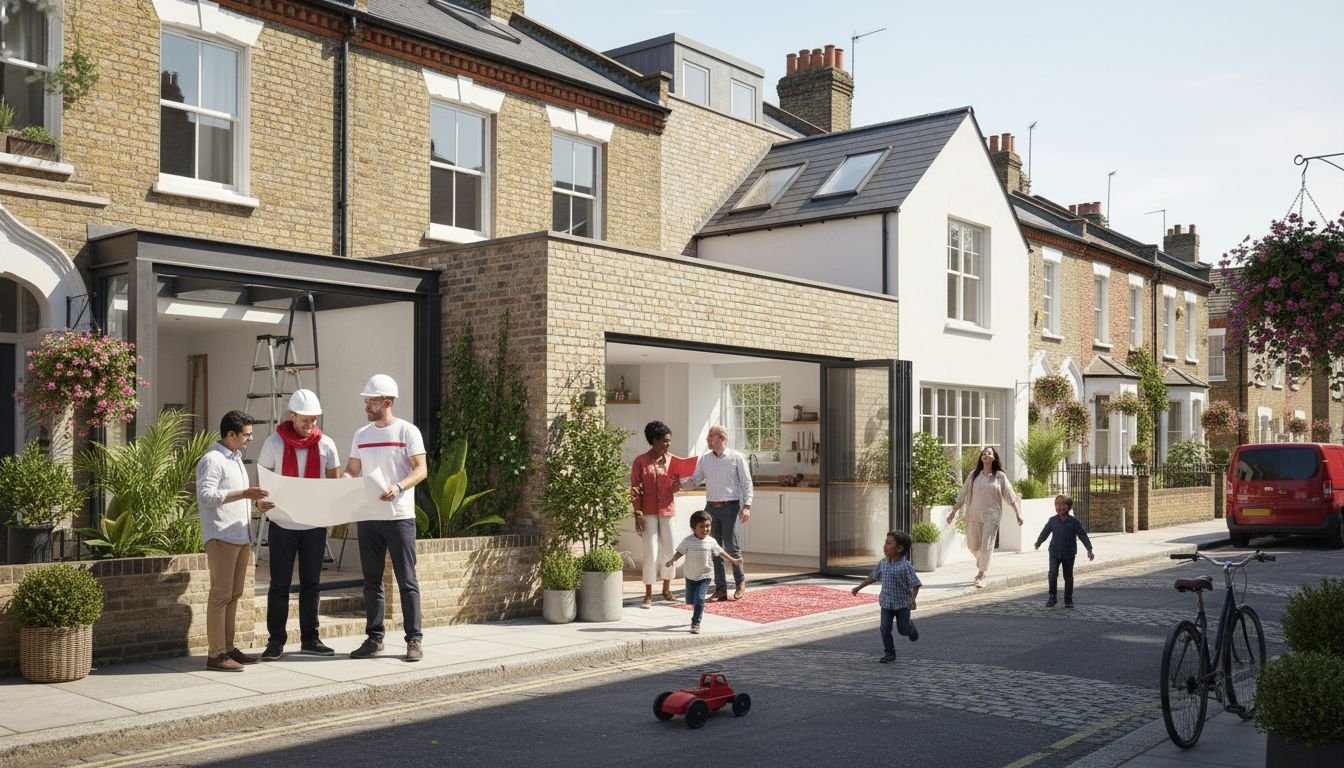Over 80 percent of London homeowners say making more space is their top reason for considering an extension. With property prices soaring and moving costs on the rise, remodelling your current home has never been more appealing. Whether you dream of a larger kitchen or need space for a growing family, understanding your extension options gives you the power to unlock your home’s true potential in the ever-changing London landscape.
Table of Contents
- 1. Understand Your Extension Options in London
- 2. Set a Realistic Budget and Use Cost Calculators
- 3. Navigate Planning Permissions and Legal Rules
- 4. Choose Reputable Extension Builders in London
- 5. Focus on Design for Functionality and Style
- 6. Plan for Project Management and Timely Delivery
- 7. Ensure Quality with Warranties and Aftercare
Quick Summary
| Takeaway | Explanation |
|---|---|
| 1. Know your extension types | Understand options like rear, side return, or loft conversions for your home. |
| 2. Create a detailed budget | Account for materials, labor, and unexpected costs to prevent financial strain. |
| 3. Navigate planning permissions | Familiarize yourself with local regulations to avoid legal issues during your extension. |
| 4. Choose reliable builders | Research builders’ credentials and experience to ensure successful project completion. |
| 5. Ensure warranties and aftercare | Secure warranties for long-term protection and peace of mind regarding quality. |
1. Understand Your Extension Options in London
Home extensions represent a powerful strategy for expanding your living space without relocating. In the dynamic property landscape of London, homeowners have multiple extension possibilities that can transform their existing property.
The first step in your extension journey involves comprehensively understanding the different extension types available. According to Hounslow Borough Council, London residents typically have several strategic options for home expansion.
Extension Types to Consider:
- Rear extensions
- Side return extensions
- Wraparound extensions
- Double storey extensions
- Loft conversions
Each extension type offers unique advantages depending on your property’s layout, budget, and specific requirements. For instance, rear extensions are particularly popular in London, providing substantial additional ground floor space without dramatically altering your property’s street appearance.
The Haringey Council provides detailed guidance about permissible extension sizes and planning requirements. This means understanding local regulations is crucial before commencing any home improvement project.
When exploring your extension options, consider factors like natural light, existing architectural style, potential impact on property value, and how the new space will integrate with your current living arrangements. A thoughtful approach ensures your extension feels like a natural progression of your home rather than an awkward add-on.
By carefully evaluating these options and consulting local planning guidelines, you can transform your London home into a more spacious and functional living environment.
2. Set a Realistic Budget and Use Cost Calculators
Budgeting represents the financial backbone of any successful home extension project. Getting your numbers right from the start prevents unexpected financial strain and ensures your London home improvement dreams remain achievable.
Key Budget Considerations:
- Material costs
- Labour expenses
- Planning permission fees
- Professional consultancy charges
- Potential contingency funds
According to Redbridge Council, extension costs can vary significantly based on square meter pricing and specific project requirements. Understanding these variables helps you create a more accurate financial plan.
London homeowners should anticipate comprehensive budgeting that goes beyond basic construction expenses. Havering Borough Council highlights the importance of factoring in building control charges, which differ depending on your extension size and type.
Pro Tip: Always allocate an additional 10% to 15% of your total budget for unexpected expenses. Construction projects frequently encounter unforeseen challenges that can impact your financial planning.
Digital cost calculators can provide preliminary estimates, helping you understand potential investment ranges before engaging professional contractors. These tools offer quick insights into probable expenses, allowing you to refine your financial strategy early in the planning process.
Remember, a well planned budget is not about cutting corners but about making informed decisions that balance your design aspirations with financial practicality. Take time to research, consult professionals, and create a comprehensive financial roadmap for your home extension journey.
3. Navigate Planning Permissions and Legal Rules
Planning permissions represent a critical gateway for transforming your London home extension dreams into legal reality. Understanding the complex landscape of local building regulations can mean the difference between a smooth project and potential costly legal complications.
Understanding the Planning Permission Requirements becomes crucial for any homeowner contemplating a property expansion. According to Hounslow Borough Council, specific conditions determine when planning permission becomes mandatory for home extensions.
Key Planning Permission Considerations:
- Extension size and location
- Impact on neighboring properties
- Conservation area restrictions
- Building height and design guidelines
- Permitted development rights
The UK Government has been exploring innovative approaches to urban development, particularly around upward extensions in London. This suggests an evolving regulatory environment that homeowners must carefully navigate.
Most single storey rear extensions can be completed under permitted development rights. However, this depends on meeting specific criteria such as maximum height, total floor area, and distance from property boundaries. Professional guidance becomes invaluable in interpreting these nuanced regulations.
Practical steps include consulting your local planning authority early, preparing detailed architectural drawings, and understanding potential restrictions specific to your property type and location. Some areas have additional conservation or heritage guidelines that can significantly impact your extension plans.
Remember that obtaining proper permissions is not just a legal requirement but also protects your investment. Unauthorized extensions can lead to enforcement actions, potential fines, or even mandatory demolition. Taking time to understand and comply with local regulations ensures a smooth and successful home improvement project.
4. Choose Reputable Extension Builders in London
Selecting the right extension builder can transform your home improvement project from a potential nightmare into a seamless, rewarding experience. Your choice of contractor will ultimately determine the quality, efficiency, and overall success of your London property expansion.
Why Choose London Extension Builders becomes a critical decision point for homeowners looking to invest in their property. According to Merton Council, choosing reputable builders involves careful research and verification.
Key Selection Criteria for Extension Builders:
- Verified professional credentials
- Comprehensive portfolio of completed projects
- Positive client testimonials
- Transparent pricing structures
- Proven experience in London property regulations
Camden Council emphasizes the importance of hiring qualified professionals who understand local building requirements and can navigate complex regulatory landscapes.
When evaluating potential builders, request detailed portfolios showcasing similar extension projects in London. Examine their track record of delivering projects within budget and timeframe. Professional builders should provide comprehensive quotations, clear timelines, and demonstrate an understanding of your specific property’s unique characteristics.
Additional recommended steps include checking professional accreditations, verifying insurance coverage, and requesting references from recent clients. A reputable builder will be transparent about their qualifications and happy to provide evidence of their expertise.
Remember that the cheapest quote is not always the best option. Prioritize quality, reliability, and a proven track record of successful London home extensions over minimal cost savings.
5. Focus on Design for Functionality and Style
A successful home extension transcends mere square footage. It represents an opportunity to reimagine your living space where aesthetic appeal meets practical functionality. Your design should tell a story that seamlessly connects your existing home with its new addition.
Design and Build Tips for Home Extensions provide crucial insights into creating spaces that are both beautiful and practical. According to London City Hall’s Housing Design Case Studies, innovative design can transform how you experience your home.
Key Design Principles:
- Maximise natural light
- Create flexible living spaces
- Maintain architectural harmony
- Consider future adaptability
- Integrate smart storage solutions
Sutton Borough Council emphasizes understanding the relationship between your extension and existing property structure. This means considering architectural coherence and ensuring the new space feels like a natural progression of your home.
Consider how different design elements can enhance functionality. Large sliding glass doors might create a seamless connection between indoor and outdoor spaces. Clever built-in furniture can maximise storage without compromising aesthetic appeal. Thoughtful material selection can also bridge design continuity between old and new sections.
Remember that great design balances visual appeal with practical living requirements. Your extension should not just look beautiful but also improve how you use and experience your home. Think about natural light flow, movement between spaces, and how the new area will integrate with your daily lifestyle.
6. Plan for Project Management and Timely Delivery
Successful home extensions require more than brilliant design they demand meticulous project management. Your ability to coordinate complex moving parts will determine whether your London home transformation becomes a smooth journey or a stressful ordeal.
Understanding the Extension Project Timeline provides critical insights into managing your home improvement effectively. According to Buckinghamshire Council’s House Extensions Design Guide, effective coordination is fundamental to project success.
Essential Project Management Elements:
- Detailed project timeline
- Clear communication channels
- Regular progress monitoring
- Contingency planning
- Defined milestone expectations
Break your extension project into manageable phases with specific timelines and responsibilities. This approach allows you to track progress, identify potential delays early, and maintain momentum. Assign clear responsibilities to your builder, architect, and any subcontractors to ensure everyone understands their role.
Professional project management involves anticipating potential challenges before they emerge. This means creating buffer time for unexpected complications, maintaining open communication with your construction team, and being prepared to make quick decisions when required.
Remember that thorough planning does not mean rigid inflexibility. The most successful extension projects balance structured timelines with the ability to adapt to unforeseen circumstances. Your goal is a well executed project that minimizes stress and delivers the home transformation you desire.
7. Ensure Quality with Warranties and Aftercare
The final chapter of your home extension journey is perhaps the most critical protecting your investment through comprehensive warranties and robust aftercare services. Your newly transformed space deserves long term protection and peace of mind.
Understanding Home Extension Project Management highlights the importance of securing proper documentation. According to Merton Council, warranties are essential for ensuring quality and longevity of home improvements.
Key Warranty and Aftercare Considerations:
- Structural warranty coverage
- Workmanship guarantee periods
- Materials quality assurance
- Post construction support
- Maintenance recommendations
Camden Council emphasizes the significance of securing comprehensive aftercare services that extend beyond the initial construction period. A robust warranty should cover potential structural issues structural integrity defects and workmanship problems.
Seek warranties that provide at least a 10 year coverage period. This demonstrates the builders confidence in their work and provides you with long term protection. Carefully review the specific terms detailing what is and is not covered to avoid potential future complications.
Remember that a quality warranty is more than a piece of paper. It represents a commitment from your builder to stand behind their work and ensure your home extension remains a source of pride and functionality for years to come.
This table summarises the key strategies and considerations for planning and executing a home extension project in London.
| Aspect | Details | Considerations |
|---|---|---|
| Extension Options | Rear, Side Return, Wraparound, Double Storey, Loft Conversions | Align choices with property layout and budget, understand local guidelines |
| Budgeting | Material costs, Labour, Fees, Consultancy charges | Use cost calculators, allocate contingency funds |
| Planning Permissions | Size, Location, Neighbour impact | Consult local authority, adhere to legal requirements |
| Builder Selection | Credentials, Portfolio, Client testimonials | Verify experience with London regulations, check accreditations |
| Design Focus | Maximise light, Flexibility, Harmony | Ensure functionality aligns with aesthetic goals |
| Project Management | Timelines, Communication, Contingency planning | Track progress, assign clear roles, stay adaptable |
| Warranties & Aftercare | Structural coverage, Workmanship guarantees | Seek long-term protection, confirm terms and coverages |
Turn Your Home Extension Vision into Reality with Expert Guidance
Navigating the complex journey of home extensions in London can feel overwhelming from managing budgets and planning permissions to choosing the right builder who understands local regulations. Many homeowners struggle with balancing design that blends style and function while ensuring timely project delivery and lasting quality backed by warranties. At Reltic Extend, we understand these challenges and offer tailored solutions that simplify each essential step outlined in the article.
Discover practical inspiration and design strategies in our Extension Inspiration & Ideas for Your Home section. Learn how expert project management ensures your extension stays on schedule and budget by exploring our Design & Build Tips for Home Extensions. Ready to take the next step towards expanding your living space with confidence and peace of mind? Contact us today at Reltic Extend to start planning your bespoke London home extension with our 20 years of proven expertise and clear, transparent service.
Frequently Asked Questions
What are the different types of home extensions I can consider for my project?
Homeowners can explore several types of home extensions, including rear extensions, side return extensions, wraparound extensions, double storey extensions, and loft conversions. To determine which type best suits your needs, evaluate your property’s layout and your specific space requirements.
How do I set a realistic budget for my home extension in London?
To create a realistic budget, consider major costs such as materials, labor, planning permission fees, and potential contingency funds. Allocate an additional 10% to 15% of your budget for unexpected expenses to ensure you can handle any unforeseen challenges during the project.
What planning permissions do I need to acquire for a home extension?
Acquiring planning permission often depends on factors like the extension’s size, location, and impact on neighboring properties. To start, consult local planning requirements and determine if your project falls under permitted development rights, as this can simplify the approval process.
How can I choose the right builders for my home extension?
Focus on builders with verified credentials, a strong portfolio, positive client testimonials, and transparent pricing structures. Request references and compare at least three detailed quotes to ensure you select a builder with a proven track record in handling similar projects.
What design considerations should I keep in mind for my home extension?
Aim to maximize natural light, create flexible living spaces, and ensure architectural harmony between your existing home and the extension. Plan for future adaptability and incorporate smart storage solutions to enhance functionality and maintain a cohesive aesthetic.
How can I effectively manage my home extension project?
To manage your project effectively, break it into manageable phases with specific timelines and milestones. Establish clear communication channels and monitor progress regularly, allowing for adjustments as needed to keep the project on track and within your set timeline.





